Intra-City Differentiation Patterns and Typological Governance Strategies for Urban Villages in Kunming: Empirical Evidence from 140 Case Studies
Abstract
1. Introduction
1.1. Research Background
1.2. Literature Review
- What are the significant differences among urban villages with varying geographic locational endowments within the same city?
- What are the core characteristics of urban villages with different geographic locational endowments?
- How should urban villages be governed differently according to their intra-city variations?
2. Materials and Methods
2.1. Research Area
2.2. Case Selection and Data Sources
2.2.1. Selection of Urban Villages in Guandu District and Anning City
2.2.2. Data Sources
2.3. Research Methods
2.3.1. Classification of Urban Villages
- Classification Criteria
- 2.
- Classification Results
2.3.2. Evaluation of Urban Village Development Status
- Indicator System Establishment
- 2.
- Weight Assignment Using the Analytic Hierarchy Process
- 3.
- Data Quantification and Standardization
2.3.3. Quantitative Comparative Analysis
3. Results
3.1. Analysis of Intra-Regional Variations in Urban Villages
3.1.1. Intra-Regional Variations in Anning City
- Ecological Environment
- 2.
- Spatial Intensity
- 3.
- Social Resilience
- 4.
- Economic Vitality
- 5.
- Comprehensive Development Status
3.1.2. Intra-Regional Variations in Guandu District
- Ecological Environment
- 2.
- Spatial Intensity
- 3.
- Social Resilience
- 4.
- Economic Vitality
- 5.
- Comprehensive Development Status
3.2. Analysis of Inter-Regional Variations in Urban Villages
- Ecological Environment
- 2.
- Spatial Intensity
- 3.
- Social Resilience
- 4.
- Economic Vitality
- 5.
- Comprehensive Development Status
3.3. Correlation Analysis
4. Discussion
4.1. Summary of Intra-City Differences in Urban Villages
4.1.1. Intra-Regional Differences Among Urban Villages
4.1.2. Inter-Regional Differentiation Among Urban Villages
4.2. Core Characteristics and Regeneration Strategies for Urban Villages
5. Conclusions
Author Contributions
Funding
Institutional Review Board Statement
Informed Consent Statement
Data Availability Statement
Acknowledgments
Conflicts of Interest
References
- State Council Office of the People’s Republic of China. Guiding Opinions on Positively and Steadily Promoting the Transformation of Urban Villages in Mega Megacities. Available online: https://www.gov.cn/zhengce/2021-10/10/content_5641727.htm (accessed on 10 October 2021).
- Ministry of Housing and Urban-Rural Development. Notice on Preventing Large-Scale Demolition and Construction in Urban Renewal Actions. Available online: https://www.gov.cn/zhengce/zhengceku/2021-08/31/content_5634560.htm (accessed on 27 June 2025).
- State Council Office of the People’s Republic of China. The 2023 State CouncilGuiding Opinions on Promoting Urban Village Regeneration in Super-Large and Megacities. Available online: https://www.gov.cn/zhengceku/content/202307/content_7025843.htm (accessed on 28 June 2025).
- Yu, W. Evolution and Reorganization of Spatial Structure in Beijing’s Urban Fringe Areas; Science Press: Beijing, China, 2012; ISBN 978-7-03-034352-9. Available online: https://book.douban.com/subject/10771460/ (accessed on 17 August 2025).
- Wehrwein, G.S. The Rural-Urban Fringe. Econ. Geogr. 1942, 18, 217–228. [Google Scholar] [CrossRef]
- U–TT Archive|Informal City: Caracas Case. Available online: http://urban-thinktank-hk.ch/utt-archive/publication/informal-city-caracas-case/ (accessed on 31 March 2025).
- Berner, E. Informal Housing: Asia. In International Encyclopedia of Housing and Home; Smith, S.J., Ed.; Elsevier: San Diego, CA, USA, 2012; pp. 56–62. ISBN 978-0-08-047171-6. [Google Scholar]
- Johnstone, M. Urban Housing and Housing Policy in Peninsular Malaysia. Int. J. Urban Reg. Res. 1984, 8, 497–529. [Google Scholar] [CrossRef]
- United Nation. Estimates and Projections of Urban, Rural and City Populations, 1950–2025: The 1982 Assessment; United Nation: New York, NY, USA, 1985. [Google Scholar]
- Roy, A. Urban Informality: Toward an Epistemology of Planning. J. Am. Plan. Assoc. 2005, 71, 147–158. Available online: https://www.tandfonline.com/doi/abs/10.1080/01944360508976689 (accessed on 31 March 2025). [CrossRef]
- Aguilar, A.G.; Ward, P.M.; Smith Sr, C.B. Globalization, Regional Development, and Mega-City Expansion in Latin America: Analyzing Mexico City’s Peri-Urban Hinterland. Cities 2003, 20, 3–21. [Google Scholar] [CrossRef]
- Willis, K. Informal Settlements. In International Encyclopedia of Human Geography; Elsevier: Amsterdam, The Netherlands, 2020; pp. 289–295. [Google Scholar]
- Loggia, C.; Govender, V. A Hybrid Methodology to Map Informal Settlements in Durban, South Africa. Proc. Inst. Civ. Eng. Eng. Sustain. 2020, 173, 257–268. [Google Scholar] [CrossRef]
- Vieda Martínez, S.; Ramírez-Mosquera, A.K.; Avalos, P.D. Impacts of Social Housing on Urban Transformations of Informal Settlements in Bogotá, Colombia. J. Hous. Built Environ. 2024, 39, 2069–2095. [Google Scholar] [CrossRef]
- Ren, X. Governing the Informal: Housing Policies Over Informal Settlements in China, India, and Brazil. Hous. Policy Debate 2018, 28, 79–93. [Google Scholar] [CrossRef]
- Tian, L. Some Reflections on China’s Land Use Development Strategy—A Discussion on the Countermeasures for the Coordinated Development of Human-Land Relations in China. Mod. Urban Stud. 1998, 62, 42–45. [Google Scholar]
- Wan, C.W.; Long, X.R. Review and Prospect of the Research on Renewal of Urban Villages in China—Literature Analysis Based on Major Journals in Urban Planning. West. Habitat J. 2022, 37, 78–86. [Google Scholar] [CrossRef]
- Zhou, X. The Urban Village Problem: An Economic Analysis of Formation, Survival and Transformation. Ph.D. Thesis, Fudan University, Shanghai, China, 2007. [Google Scholar]
- Yao, M. Study on the Transformation Strategy of “City-Side Villages” in the Development of New Areas of Xi’an City. Master’s Thesis, Xi’an University of Architecture and Technology (XUAT), Xi’an, China, 2009. [Google Scholar]
- Liu, W. Study on the Renewal Strategy of Shenzhen Urban Villages under the Concept of Urban Repair—Taking Shootgang Village as an Example. Archit. Cult. 2021, 126–128. [Google Scholar] [CrossRef]
- Fan Experience and Reference of Urban Village Development Based on Strategy Orientation; China Construction Company: Beijing, China, 2014; pp. 62–63.
- Yin, Y. Enhancement of Housing Rental and Livelihood Capacity of Households of Urban Village Demolition and Rehabilitation Residents—A Case Study of Eight Demolition and Rehabilitation Neighborhoods in Hanyang District of Wuhan City. Urban Issues 2020, 86–93, 103. [Google Scholar] [CrossRef]
- Zhang, D.; Cai, Y. The Differentiation of Housing Properties of Demolished and Relocated Residents in Urban Villages and Its Influencing Factors—Taking Two Demolished and Relocated Resettlement Areas in Wuhan City as an Example. Urban Issues 2018, 55–65. [Google Scholar] [CrossRef]
- Zhang, L. Comparison of Urban Renewal Governance Models and Transformation Path under the “New Normal”. Urban Dev. Stud. 2015, 22, 57–62. [Google Scholar]
- Lin, Y. Rural Industrialization in Semi-Urbanized Areas under the Perspective of Rural Governance: A Comparative Study Based on the Pearl River Delta, Southern Jiangsu and Wenzhou. J. Urban Plan. 2015, 101–110. [Google Scholar] [CrossRef]
- Wan, C. Public Product Orientation: Urban Village Renewal with Multi-Center Governance: The Case of Shenzhen Shuiwei Lemon League Talent Apartments. Int. Urban Plan. 2021, 36, 138–147. [Google Scholar] [CrossRef]
- Jiang, C.; Wang, T. Experimenting with Planning Control Reforms to Promote Clear Property Rights—And the Transformation of “Villages in Cities”. Town Plan. 2002, 33–40. [Google Scholar]
- Chen, Z. Multi-Faceted Thinking in the Transformation of “Urban Village”-Xiamen Lingdou Village Transformation Planning Practice. Planner 2016, 32, 21–24. [Google Scholar]
- Chen, S.; Zhao, W.; Hu, S. Study on Urban Village Transformation Planning under the Perspective of Habitat Environment Theory—Taking Wuhan City as an Example. Town Plan. 2009, 33, 37–42. [Google Scholar]
- Liu, M. Institutional Analysis of the Mechanisms of the Generation and Continuity of Urban Villages; Guangdong Social Sciences: Guangzho, China, 2010; pp. 157–162. [Google Scholar]
- Lan, Y. Urban Village Community—A Case Study on the Organizational and Lifestyle Approach to Peasant Urbanization. Soc. Sci. China 2005, 144–154, 207. [Google Scholar]
- He, L. Why Urban Villages Make a Difference—Distinguishing Between Same-City Differences and Different-City Differences. Acad. Mon. 2018, 50, 80–89. [Google Scholar] [CrossRef]
- Zhang, X.; Yuan, P.; Shan, R. An Innovative Discussion of Structural Zoning in Urban Master Planning. Shanghai Urban Plan. 2023, 145–151. [Google Scholar] [CrossRef]
- Ye, Y. Chinese-style modernization and transformation of urban villages in mega mega cities. Planner 2024, 40, 152–159. [Google Scholar]
- Liu, J.; Long, F.; Chen, L.; Zheng, L.; Mi, Z. The Role of Polycentric Urban Structures in Shaping Low-Carbon Lifestyles. Cities 2025, 157, 105616. [Google Scholar] [CrossRef]
- Gurría-Gascón, J.-L.; Sánchez-Martín, J.-M.; Ruiz-Labrador, E.-E.; Hernández-Carretero, A.-M. Polycentric Urban System, Territorial Development and Resilience of the Rural Population (Extremadura, Spain). Urban Sci. 2024, 8, 144. [Google Scholar] [CrossRef]
- Meijers, E.J.; Burger, M.J. Spatial Structure and Productivity in US Metropolitan Areas. Environ. Plan. A Econ. Space 2010, 42, 1383–1402. [Google Scholar] [CrossRef]
- Burger, M.J.; Meijers, E.J.; Hoogerbrugge, M.M.; Tresserra, J.M. Borrowed Size, Agglomeration Shadows and Cultural Amenities in North-West Europe. Eur. Plan. Stud. 2014, 23, 1090–1109. [Google Scholar] [CrossRef]
- GB/T 51328-2018; Urban Comprehensive Transportation System Planning Standard. China Architecture & Building Press: Beijing, China, 2018.
- Chan, R.C.K.; Yao, Y.M.; Zhao, S.X.B. Self-Help Housing Strategy for Temporary Population in Guangzhou, China. Habitat Int. 2003, 27, 19–35. [Google Scholar] [CrossRef]
- Leaf, M. A Tale of Two Villages: Globalization and Peri-Urban Change in China and Vietnam. Cities 2002, 19, 23–31. [Google Scholar] [CrossRef]
- Liu, X.; Liang, W. Zhejiangcun: Social and Spatial Implications of Informal Urbanization on the Periphery of Beijing. Cities 1997, 14, 95–108. [Google Scholar] [CrossRef]
- Witten, K.; Exeter, D.; Field, A. The Quality of Urban Environments: Mapping Variation in Access to Community Resources. Urban Stud. 2003, 40, 161–177. [Google Scholar] [CrossRef]
- Chiang, C.-L.; Liang, J.-J. An Evaluation Approach for Livable Urban Environments. Environ. Sci. Pollut. Res. 2013, 20, 5229–5242. [Google Scholar] [CrossRef] [PubMed]
- Das, D. Urban Quality of Life: A Case Study of Guwahati. Soc. Indic. Res. 2007, 88, 297–310. [Google Scholar] [CrossRef]
- Zhang, R.; Lu, J. Characteristics of Rural Development Evaluation and Spatial and Temporal Divergence in the Yangtze River Delta Region. J. Ecol. Rural. Environ. 2021, 37, 698–705. [Google Scholar] [CrossRef]
- Han, X. Study on Comprehensive Evaluation and Type Identification of Rural Development in the Context of Rural Revitalization. China Popul. Resour. Environ. 2019, 29, 156–165. [Google Scholar]
- Xu, M. Comprehensive Evaluation of Rural Development Level Based on Data Mining; Springer: Cham, Switzerland, 2020; Available online: https://link.springer.com/chapter/10.1007/978-3-030-62743-0_93#citeas (accessed on 27 June 2025).
- Qi, Y. Application of Hierarchical Analysis-Entropy Weighting Method to the Evaluation of Geological Hazard Vulnerability in Mountain Towns and Cities. Surv. Mapp. Bull. 2021, 5, 112–116. [Google Scholar]
- Saaty, R.W. The Analytic Hierarchy Process—What It Is and How It Is Used. Math. Model. 1987, 9, 161–176. [Google Scholar] [CrossRef]
- Zhou, H.; Chang, J. Planning and Construction Strategies for Infrastructure in Traditional Villages of the Grand Canal from the Perspective of Villager Needs. Buildings 2024, 14, 3560. [Google Scholar] [CrossRef]
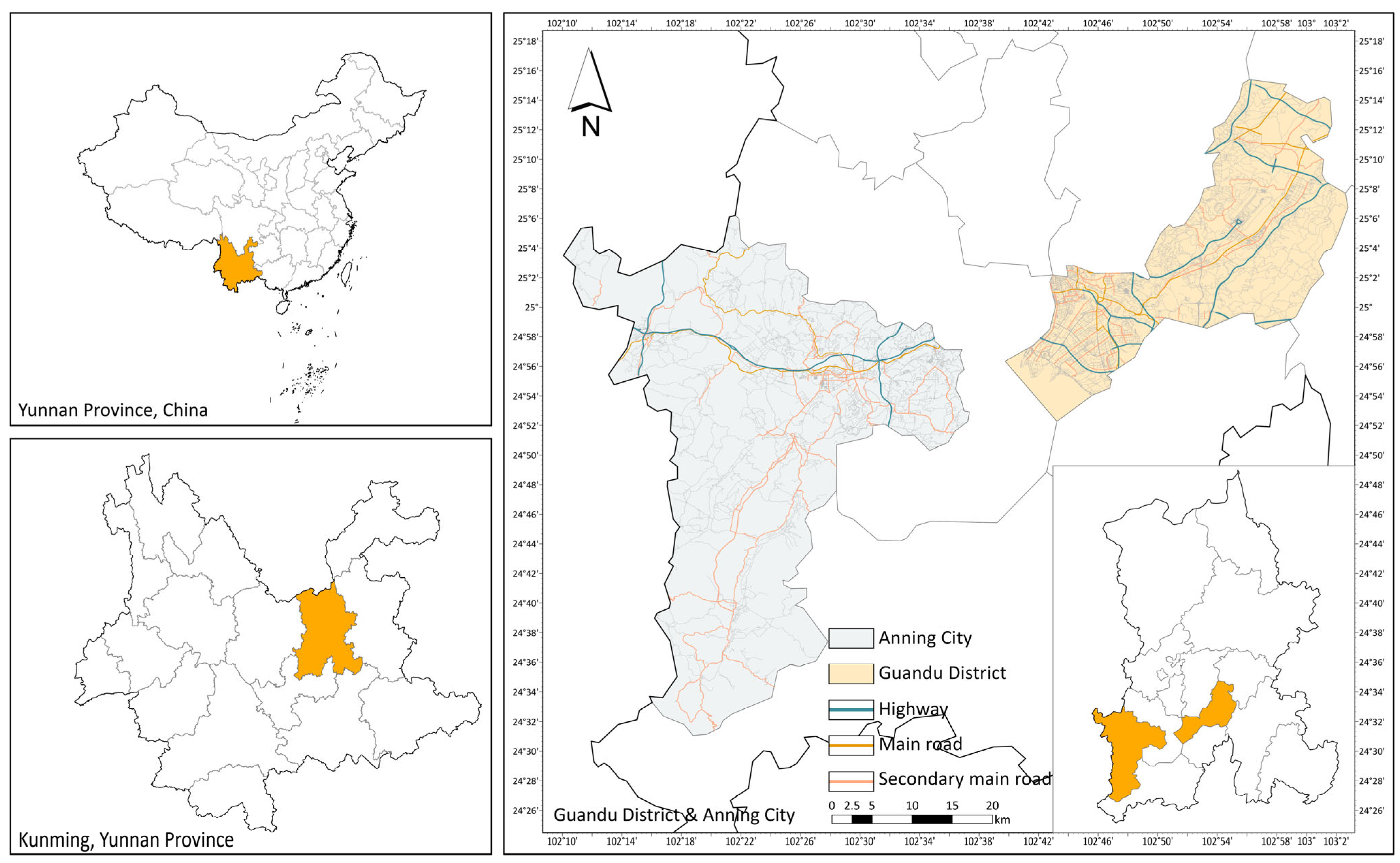

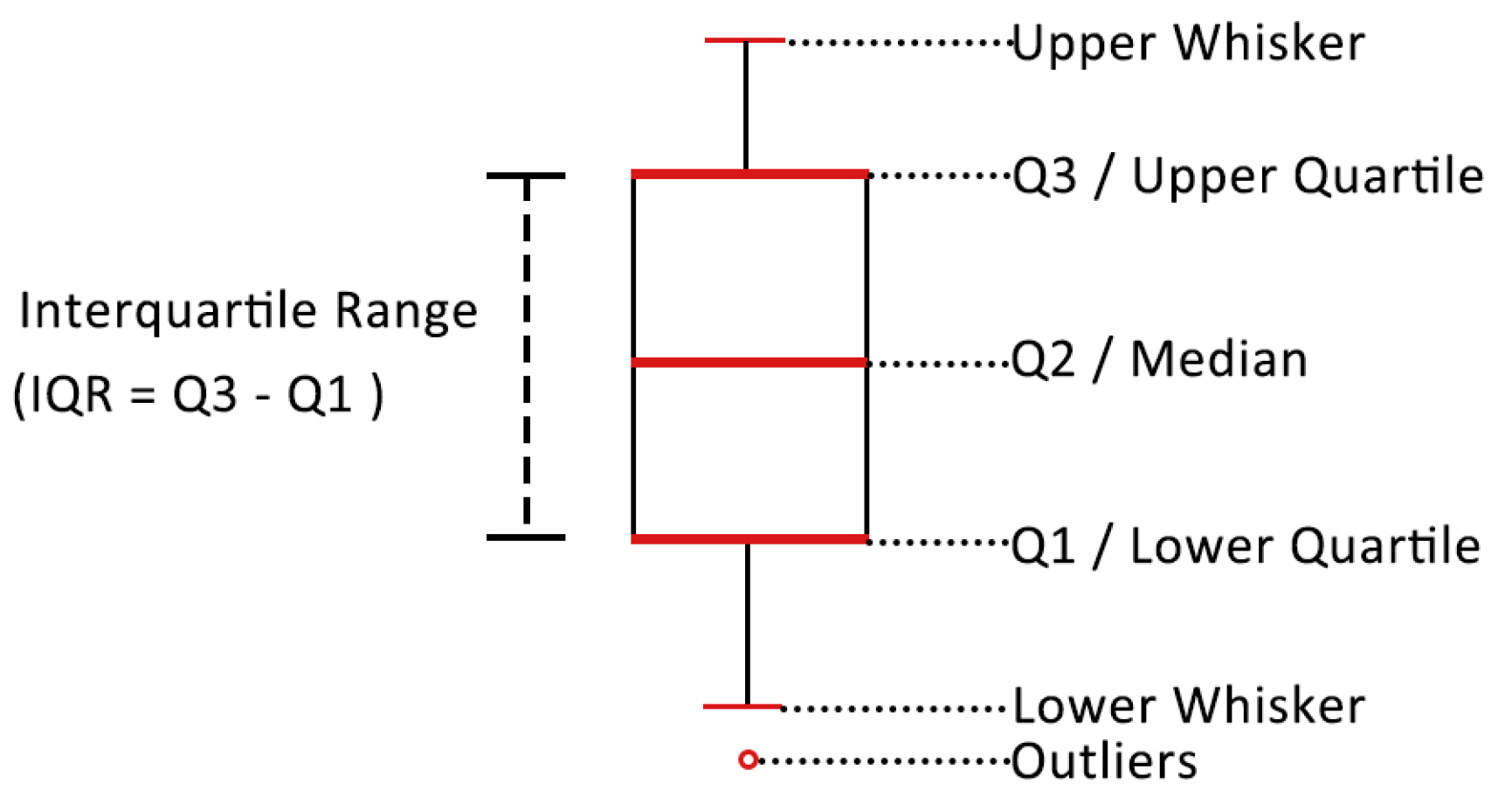
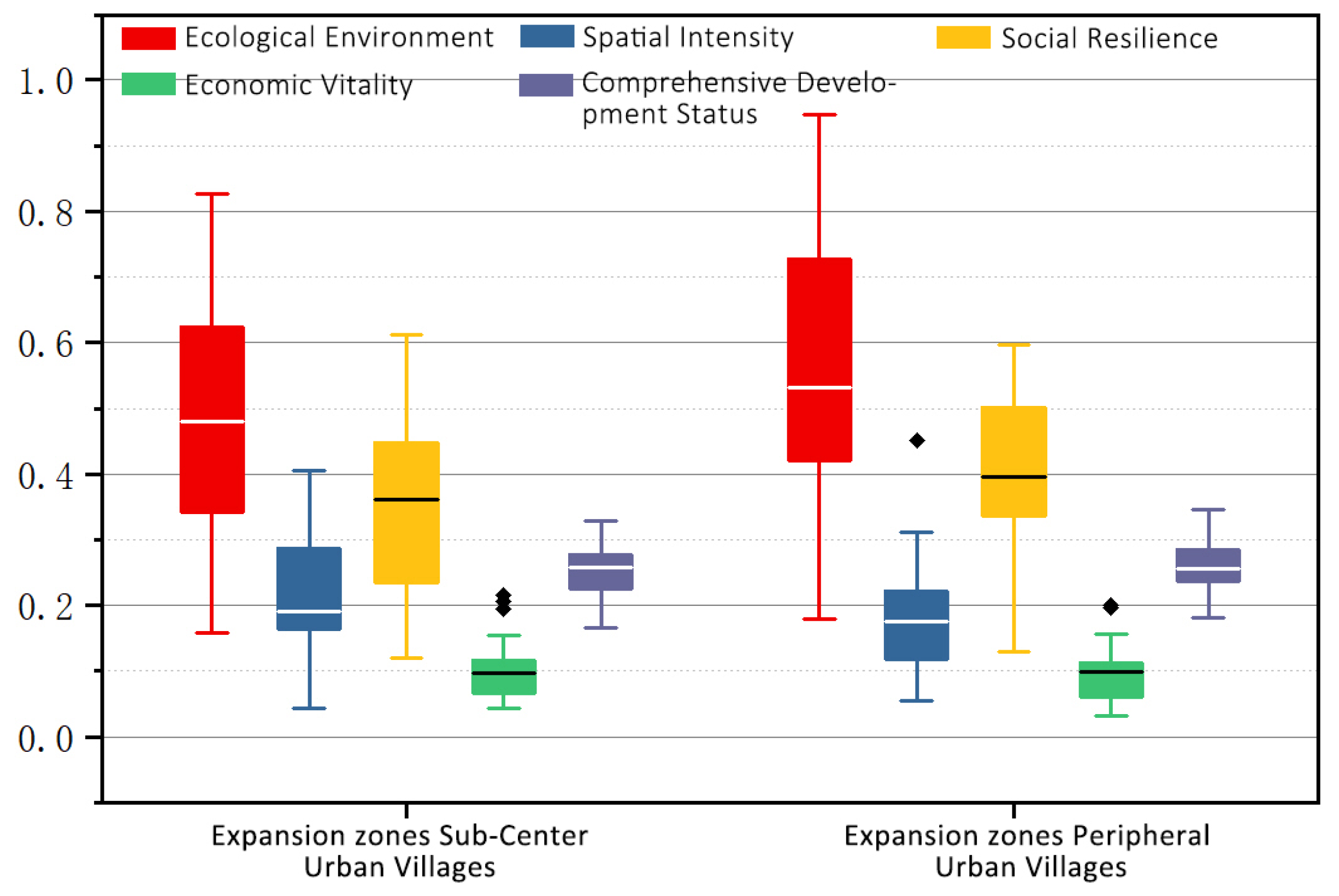


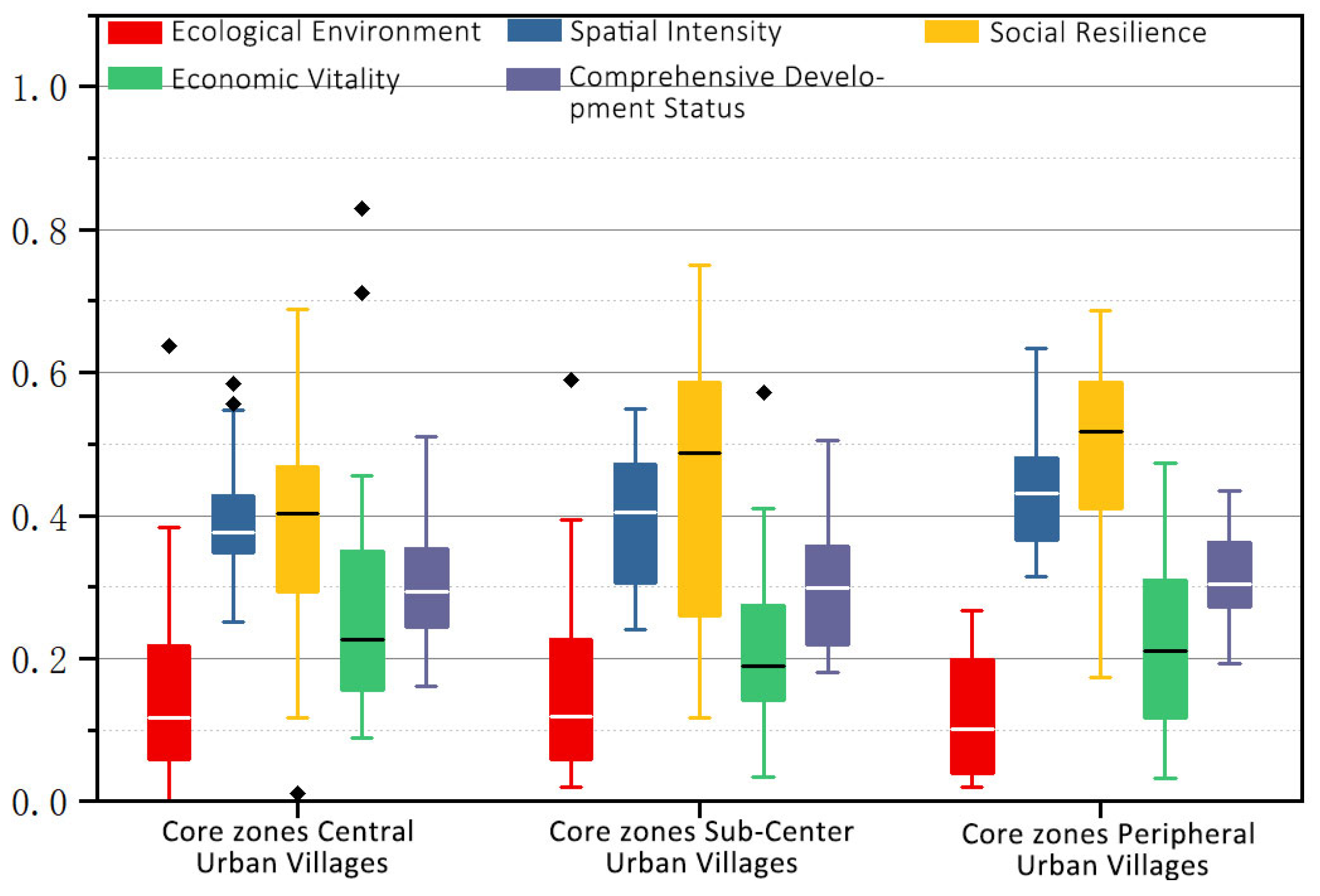
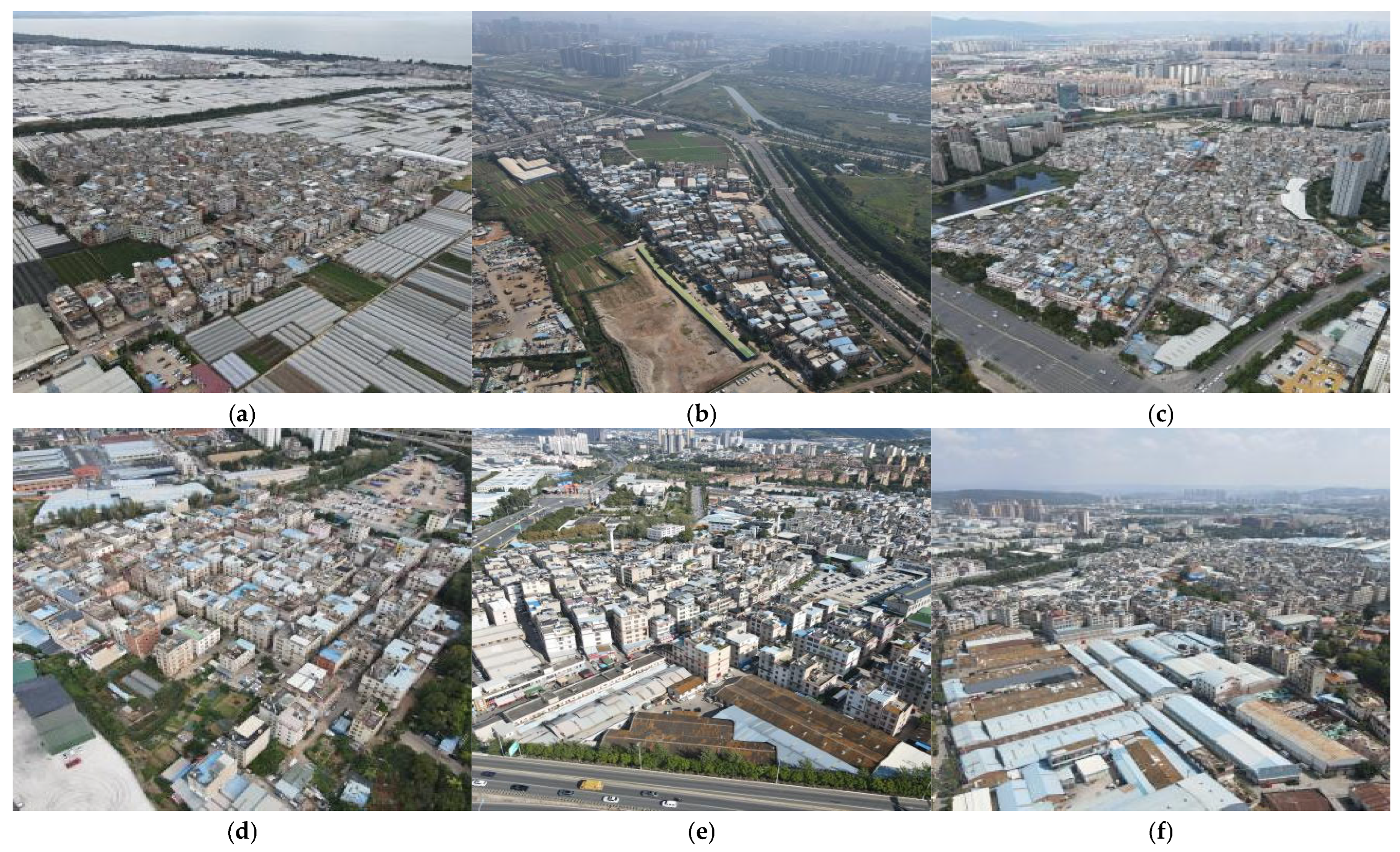

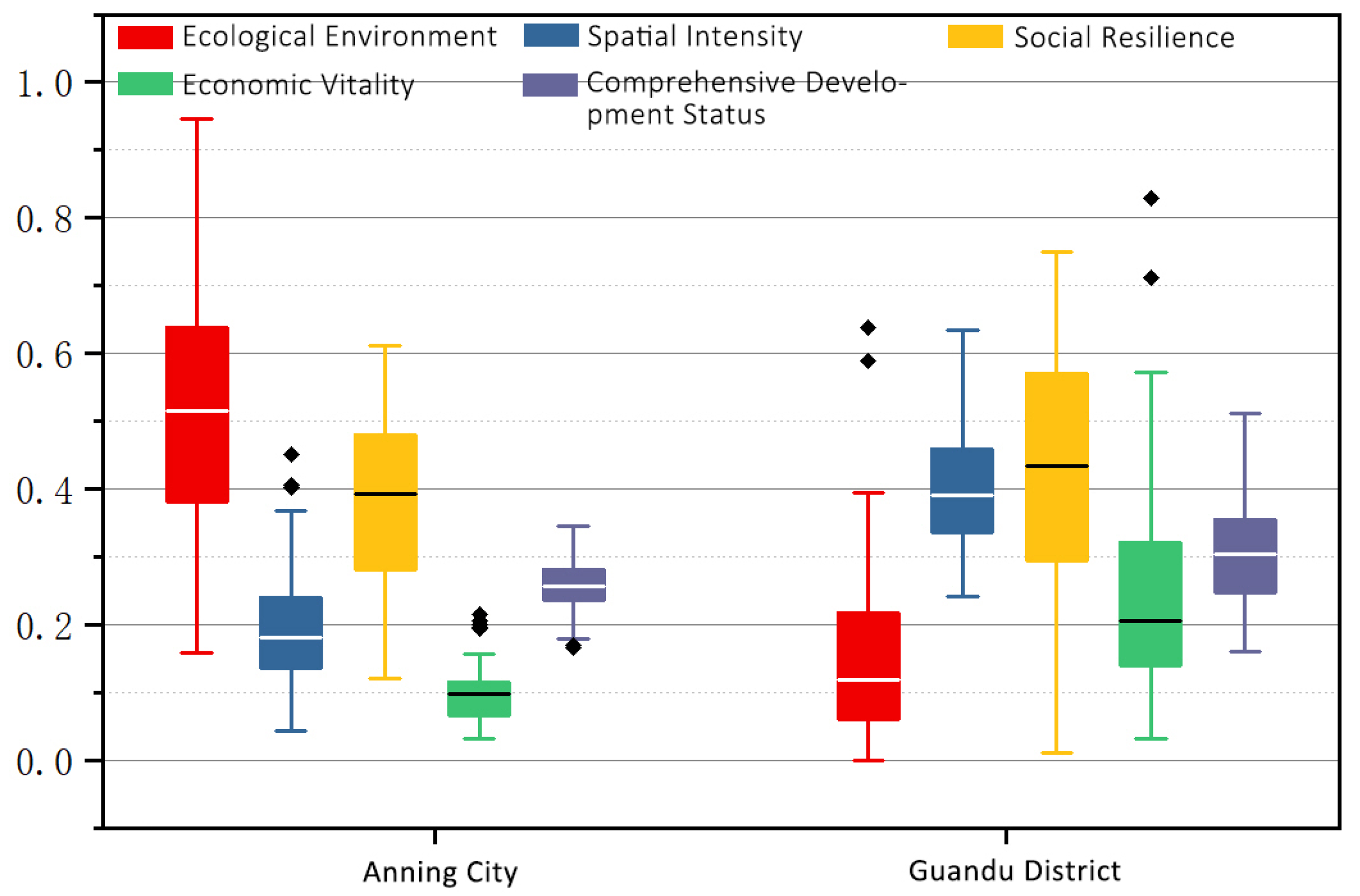
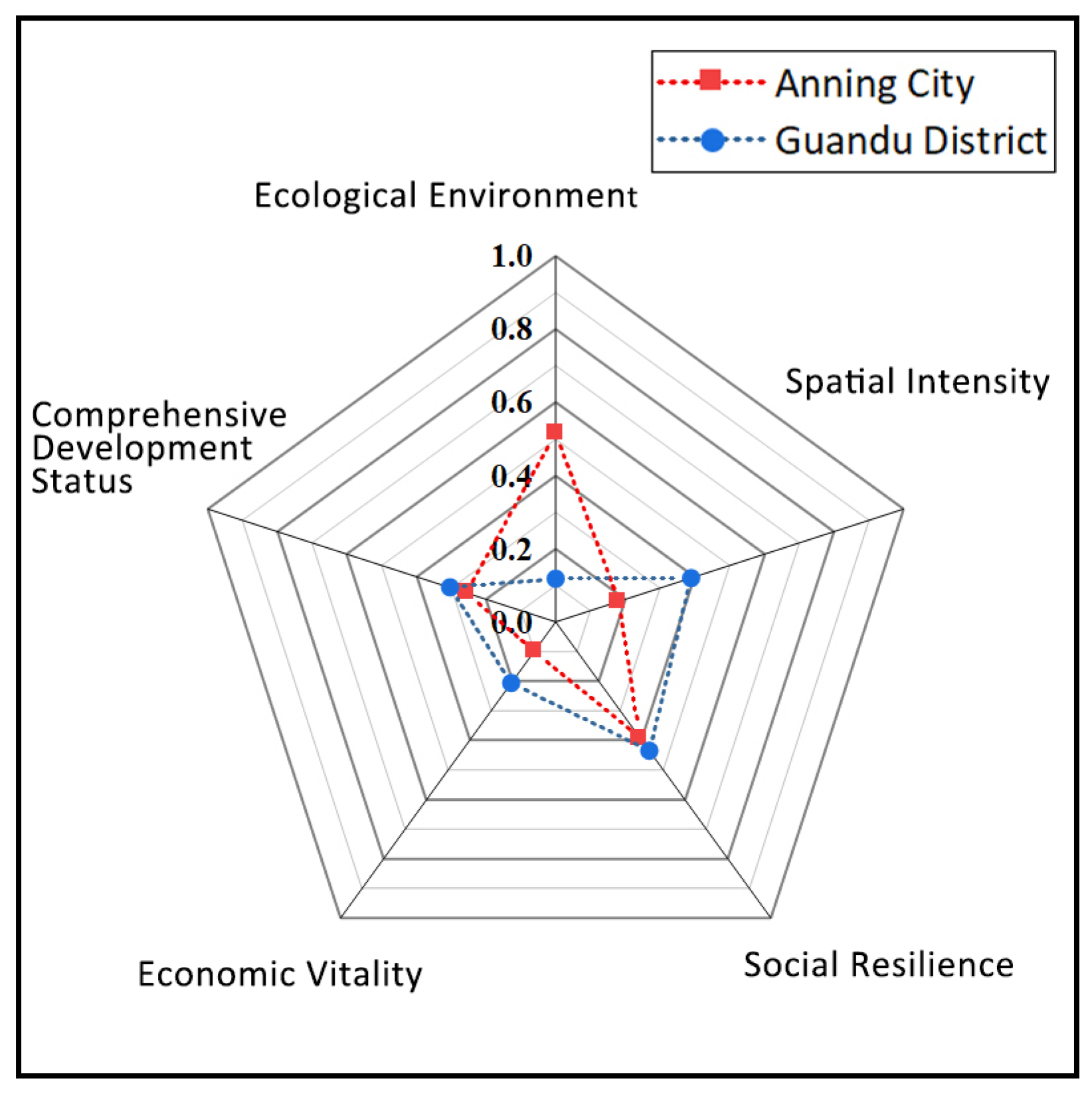
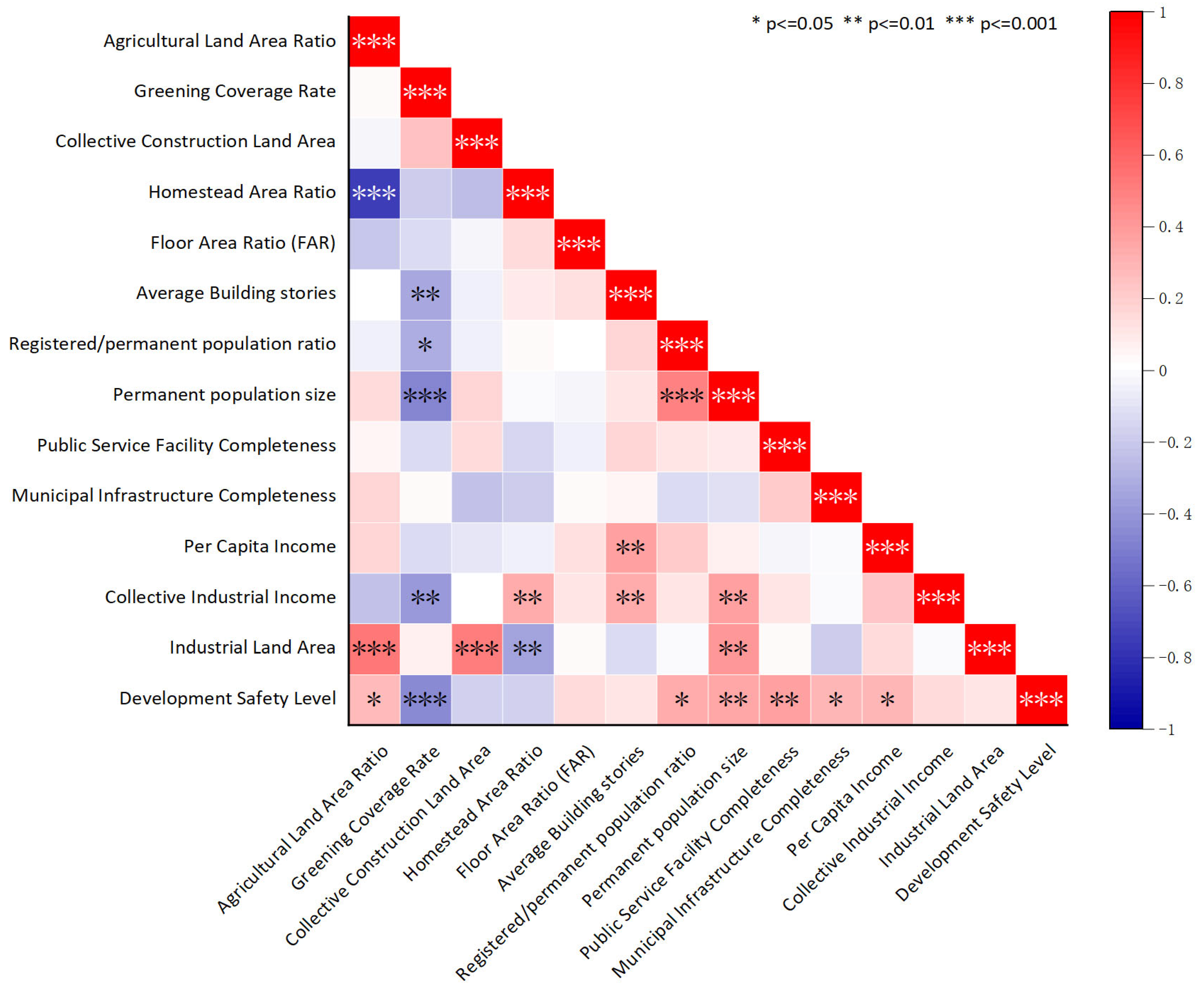
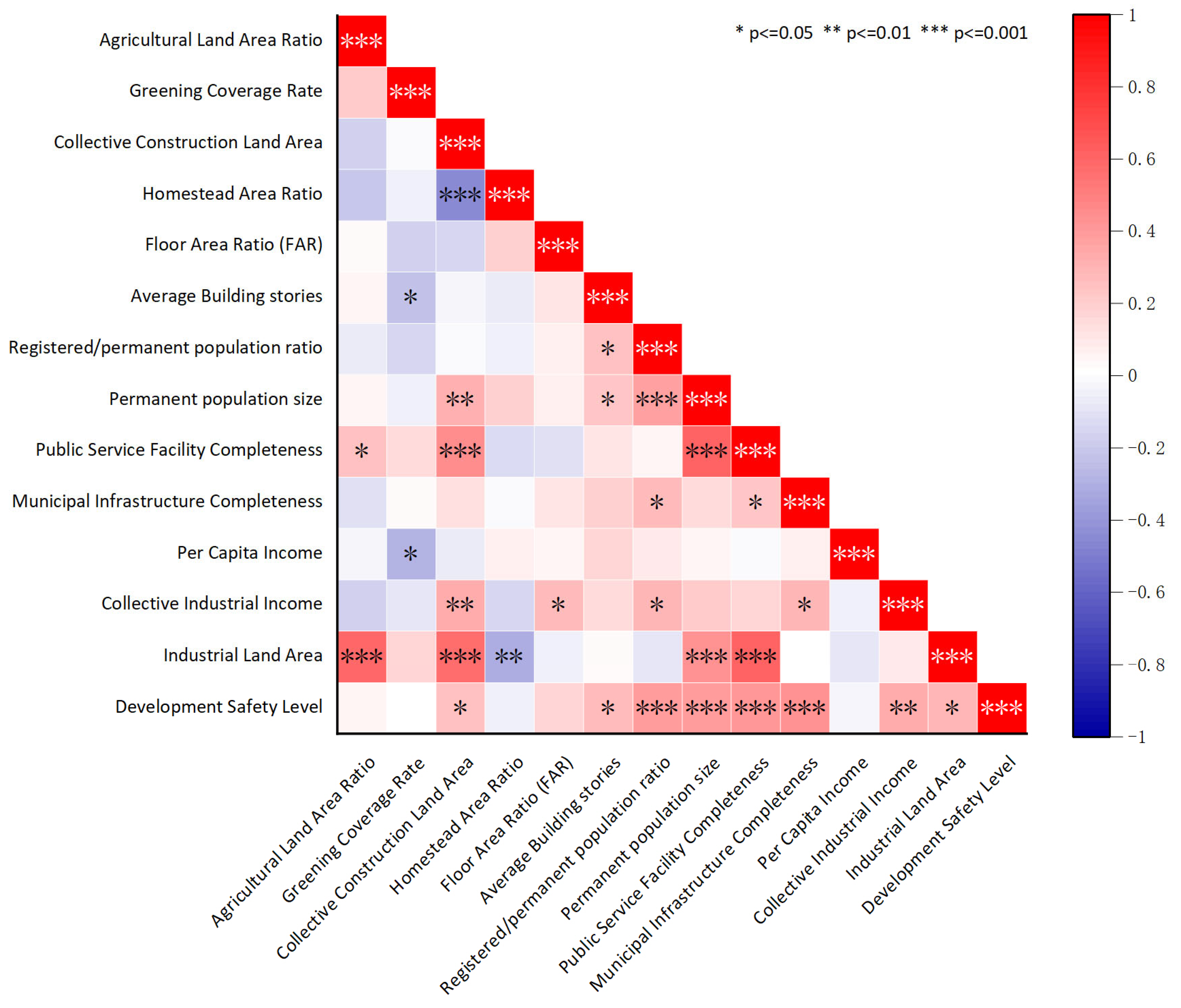
| Category | Criteria Fulfillment | Region | Quantity |
|---|---|---|---|
| Core zones Central Urban Villages | Meet two or all three criteria | Guandu District | 34 |
| Expansion zones Central Urban Villages | Anning City | 0 | |
| Core zones Sub-Center Urban Villages | Meet one criterion | Guandu District | 32 |
| Expansion zones Sub-Center Urban Villages | Anning City | 29 | |
| Core zones Peripheral Urban Villages | Meet none of the criteria | Guandu District | 14 |
| Expansion zones Peripheral Urban Villages | Anning City | 31 |
| Evaluation Dimension | Assessment Focus | Data Support | Data Description and Processing Methods |
|---|---|---|---|
| Ecological Environment | Agricultural Development Resources | Agricultural Land Area Ratio | Reflects agricultural development level; Obtained through interviews and satellite imagery to calculate the ratio of agricultural land to collective land area. |
| Ecological Development Resources | Greening Coverage Rate | Measures ecological construction status; Acquired via drone aerial photography for village-wide high-resolution images. Evaluated using a five-point Likert scale (1–5) based on green coverage, with scores averaged by six researchers. | |
| Spatial Intensity | Land Use Intensity | Collective Construction Land Area | Reflects land development potential; Precise data obtained through village cadres’ interviews. |
| Homestead Area Ratio | Reflects self-built housing intensity; Calculated as homestead area divided by collective construction land area (data from cadres’ interviews). | ||
| Building Space Intensity | Floor Area Ratio (FAR) | Quantifies total development scale; Scored 3, 2, or 1 based on policy thresholds: ≤1.5, 1.5–2, or ≥2. | |
| Average Building stories | Reflects vertical construction intensity; Determined via street view imagery and interview records. | ||
| Social Resilience | Demographic stability | Registered/permanent population ratio | Indicates population inversion and governance challenges; Calculated from cadres’ interview data. |
| Permanent population size | Reflects population scale potential; Precise data from cadres’ interviews. | ||
| Basic service provision | Public Service Facility Completeness | Reflects basic living security; Field surveys record administrative, cultural, educational, sports, medical, commercial, and elderly care facilities (1 point per facility, max 7 points). | |
| Municipal Infrastructure Completeness | Reflects spatial carrying capacity; Field surveys evaluate road integrity, parking facilities, water supply, drainage, gas, and sanitation facilities (1 point per facility, max 7 points). | ||
| Economic Vitality | Resident Economic Base | Per Capita Income | Reflects residents’ wealth level; Precise data from cadres’ interviews. |
| Collective Industrial Income | Reflects collective industrial development; Data from cadres’ interviews. | ||
| Industrial development quality | Industrial Land Area | Reflects industrial space potential; Precise data from cadres’ interviews. | |
| Development Safety Level | Reflects risk management capacity; Field surveys assess fire safety (fire exits, turnarounds, stations, hydrants, extinguishers, smoke detectors), public safety (shelters, emergency exits, pandemic pathways), and security (surveillance, streetlights, migrant population management). Scored 1 point per item, max 12 points. |
| Goal Level (O) | Criterion Level (C) | Weight | Sub-Criterion Level (SC) | Weight | Indicator Level(I) | Weight |
|---|---|---|---|---|---|---|
| Comprehensive Development Status | Ecological Environment | 0.18 | Agricultural Development Resources | 0.25 | Agricultural Land Area Ratio | 1 |
| Ecological Development Resources | 0.75 | Greening Coverage Rate | 1 | |||
| Spatial Intensity | 0.28 | Land Use Intensity | 0.67 | Collective Construction Land Area | 0.52 | |
| Homestead Area Ratio | 0.48 | |||||
| Building Space Intensity | 0.33 | Floor Area Ratio (FAR) | 0.38 | |||
| Average Building stories | 0.62 | |||||
| Social Resilience | 0.19 | Demographic stability | 0.25 | Registered/permanent population ratio | 0.36 | |
| Permanent population size | 0.64 | |||||
| Basic service provision | 0.75 | Public Service Facility Completeness | 0.47 | |||
| Municipal Infrastructure Completeness | 0.53 | |||||
| Economic Vitality | 0.35 | Resident Economic Base | 0.67 | Per Capita Income | 0.56 | |
| Collective Industrial Income | 0.44 | |||||
| Industrial development quality | 0.33 | Industrial Land Area | 0.38 | |||
| Development Safety Level | 0.62 |
| Category | Key Characteristics | Governance Objectives | Recommended Strategies |
|---|---|---|---|
| Core zones Central Urban Villages | -High-density mixed-use development -Adjacent to transit hubs -Service overload from population inversion -Land capitalization conflicts -Occasional high-value agriculture | Achieve vertical spatial efficiency Alleviate population pressure Enable eco-economic synergy | 1. TOD-oriented 3D development 2. Flexible land exchange mechanisms 3. Tiered service systems 4. Preservation of agricultural patches |
| Core Zone Sub-Center Urban Villages | -Moderate accessibility -Reduced land use conflicts -Contiguous farmland preservation | Enhance living quality Strengthen residential function Promote moderate mixed-use | 1. Functional retrofitting 2. Collective land consolidation 3. Agricultural corridor construction 4. Neighborhood service upgrades |
| Core Zone Peripheral Urban Villages | -Highest social resilience -Low redevelopment costs -Homogeneous low-intensity development | Preserve social networks Activate cultural capital Develop peri-urban tourism | 1. Incremental infrastructure upgrades 2. Craft workshop implantation 3. Farm market + eco-lodge development |
| Expansion Zone Sub-Center Urban Villages | -Strong ecological base -Low spatial efficiency -“Weak overall, strong locally” economy | Protect ecological assets Replicate success models Unlock development potential | 1. Mountain/farmland conservation 2. “Specialty resources + collective operations” model 3. Recreational space transformation |
| Expansion zones Peripheral Urban Villages | -Superior underutilized ecology -Agriculture-dominated economy -Service deficiencies | Realize ecological value Address service gaps Ensure sustainable development | 1. Digital agricultural chains 2. Carbon trading mechanisms 3. Mobile health/education services 4. Collective land consolidation |
Disclaimer/Publisher’s Note: The statements, opinions and data contained in all publications are solely those of the individual author(s) and contributor(s) and not of MDPI and/or the editor(s). MDPI and/or the editor(s) disclaim responsibility for any injury to people or property resulting from any ideas, methods, instructions or products referred to in the content. |
© 2025 by the authors. Licensee MDPI, Basel, Switzerland. This article is an open access article distributed under the terms and conditions of the Creative Commons Attribution (CC BY) license (https://creativecommons.org/licenses/by/4.0/).
Share and Cite
Duan, W.; Ren, J.; Yang, S.; Zhao, J.; Rao, J.; Tao, N. Intra-City Differentiation Patterns and Typological Governance Strategies for Urban Villages in Kunming: Empirical Evidence from 140 Case Studies. Buildings 2025, 15, 2943. https://doi.org/10.3390/buildings15162943
Duan W, Ren J, Yang S, Zhao J, Rao J, Tao N. Intra-City Differentiation Patterns and Typological Governance Strategies for Urban Villages in Kunming: Empirical Evidence from 140 Case Studies. Buildings. 2025; 15(16):2943. https://doi.org/10.3390/buildings15162943
Chicago/Turabian StyleDuan, Wen, Jiarui Ren, Siyu Yang, Jiarong Zhao, Jiacheng Rao, and Nan Tao. 2025. "Intra-City Differentiation Patterns and Typological Governance Strategies for Urban Villages in Kunming: Empirical Evidence from 140 Case Studies" Buildings 15, no. 16: 2943. https://doi.org/10.3390/buildings15162943
APA StyleDuan, W., Ren, J., Yang, S., Zhao, J., Rao, J., & Tao, N. (2025). Intra-City Differentiation Patterns and Typological Governance Strategies for Urban Villages in Kunming: Empirical Evidence from 140 Case Studies. Buildings, 15(16), 2943. https://doi.org/10.3390/buildings15162943





